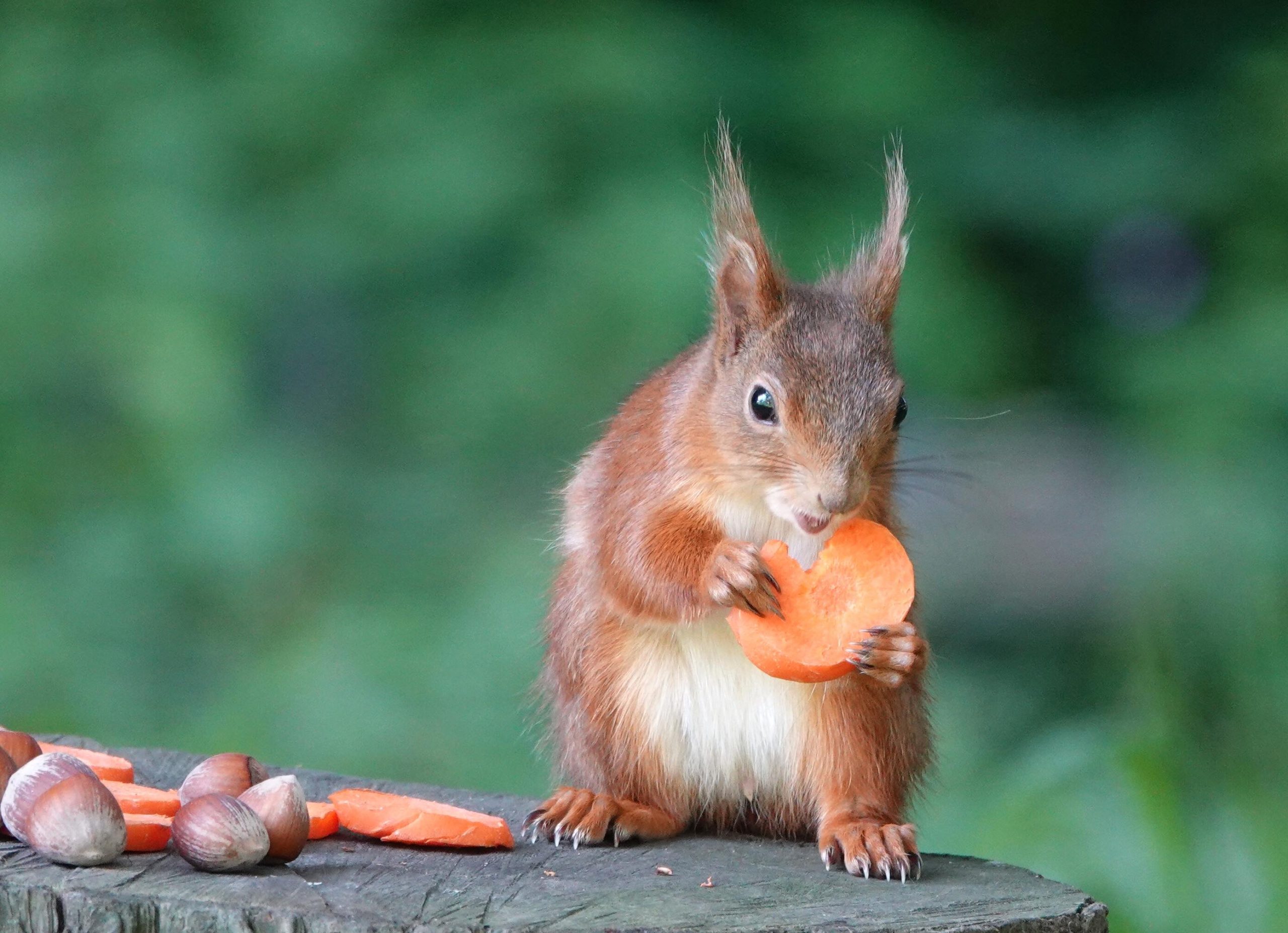The red squirrel (Sciurus vulgaris) is an agile rodent found primarily in Eurasian forests.
Red squirrels are known for their vibrant reddish-brown fur and bushy tails, they are a subject of interest for ecologists and nature enthusiasts alike. Here we will explore the first three months of a baby red squirrel’s life, from birth to the brink of independence, highlighting the biological, behavioral, and environmental factors that shape their growth.
Birth and Early Development
Red squirrels give birth after a gestation period of approximately 38-39 days. Typically, litters consist of three to six young, known as kittens. Born blind, deaf, and hairless, these altricial young are entirely dependent on their mother. Weighing around 10-15 grams at birth, they reside in a well-constructed drey (nest) made of twigs, leaves, and moss, strategically located in a tree hollow or fork to offer protection from predators and harsh weather conditions.
The mother squirrel is the primary caregiver, and her role is pivotal during the initial weeks. She feeds the kittens with nutrient-rich milk, which is essential for their rapid growth. The first notable milestone occurs around three weeks of age when fine fur begins to cover their bodies, providing some insulation and camouflage.
Sensory and Motor Development
Between four and six weeks, baby red squirrels experience significant sensory and motor development. Their eyes open around day 28-30, revealing a world previously obscured. This newfound vision is critical for their spatial awareness and future navigation through the forest canopy. Concurrently, their auditory senses develop, enabling them to react to sounds and communicate with their mother and siblings.
As their muscles strengthen, the kittens start exploring their immediate surroundings within the drey. By the seventh week, they begin to venture outside the nest under the watchful eye of their mother. These forays are short and cautious, allowing the young squirrels to practice climbing and jumping – skills vital for evading predators and foraging.
Weaning and Dietary Transition
Weaning is a gradual process that starts around six weeks and can extend up to ten weeks. During this period, the kittens’ diet shifts from solely maternal milk to solid foods. The mother introduces them to various food sources, including seeds, nuts, berries, and fungi. This dietary diversification is crucial for their development, as it not only provides essential nutrients but also acquaints them with the types of food available in their habitat.
Foraging behavior is learned through imitation. The young squirrels observe their mother’s techniques for locating and processing food, such as peeling cones to extract seeds or digging up hidden caches. This learning phase is critical, as the ability to find and store food efficiently will determine their survival during the colder months.
Social Interaction and Play
Play behavior is prominent during the weaning period and serves multiple functions. Play-fighting, chasing, and tumbling help in honing their physical abilities and establishing social hierarchies. These interactions are essential for developing coordination, strength, and social skills necessary for adult life.
While red squirrels are generally solitary animals, the early social interactions with siblings play a role in their behavioral development. Through these interactions, the young squirrels learn about dominance, submission, and territory boundaries.
Independence and Dispersal
By the end of the third month, the young red squirrels are nearly ready for independence. They are weaned, proficient climbers, and have developed the necessary skills to forage and evade predators. Around this time, they begin to spend less time in the drey and more time exploring their environment.
Dispersal typically occurs between 10 to 12 weeks of age. Juvenile red squirrels leave their natal area to establish their own territories. This dispersal reduces competition for resources and decreases the likelihood of inbreeding. During this critical phase, the young squirrels must find a suitable territory with ample food supply and secure nesting sites.
Challenges and Survival
The first three months of a baby red squirrel’s life are fraught with challenges. Predation, disease, and environmental factors pose significant risks. Common predators include birds of prey, such as hawks and owls, as well as land based predators like foxes and domestic cats. Harsh weather can also impact survival rates, especially if food is scarce or if the dreys are not adequately insulated and of course there is the issue of our impact as human beings, notably the cars that we drive claim many red squirrel lives each year.
Despite these challenges, the adaptability and learning capabilities of red squirrels enable a significant number to reach maturity. Their survival strategies, such as caching food for winter and utilizing complex vocalisations to warn of danger, illustrate their evolutionary resilience.
Conclusion
The journey from a helpless newborn to an independent juvenile is a remarkable period in the life of a red squirrel. Each stage, from sensory development to learning to forage, is a testament to the intricate balance of innate behaviors and environmental learning. Understanding these early life stages provides insight into the survival strategies of red squirrels and underscores the importance of preserving their natural habitats to ensure their continued existence.
Photograph kindly provided by Debbie Hart

